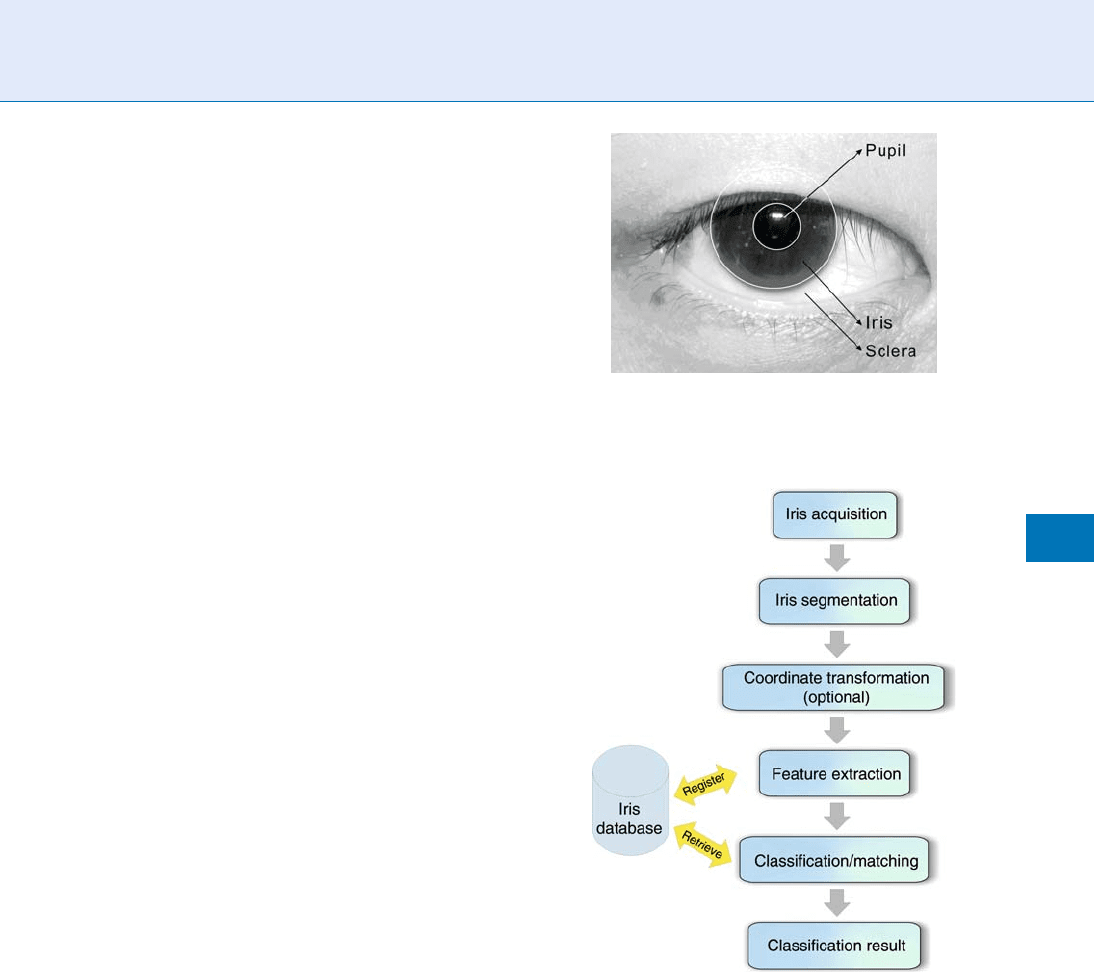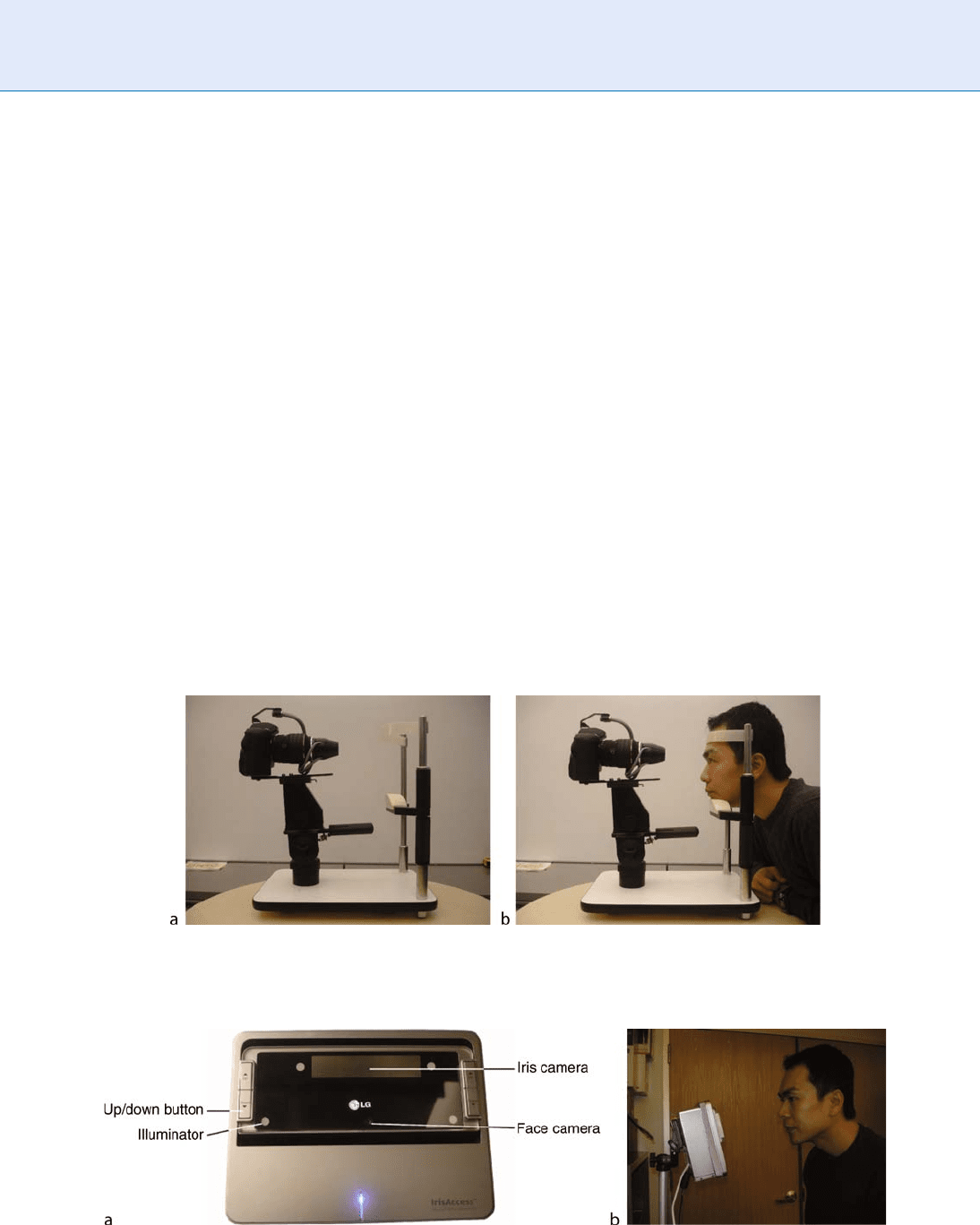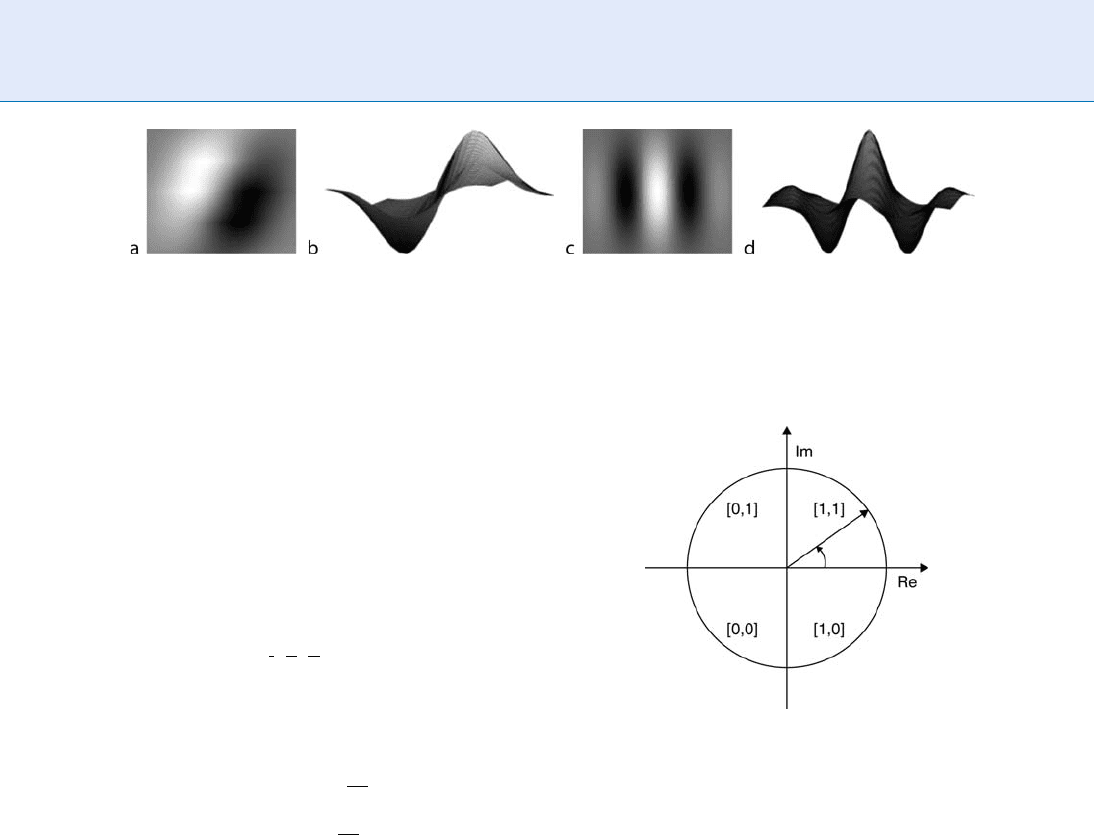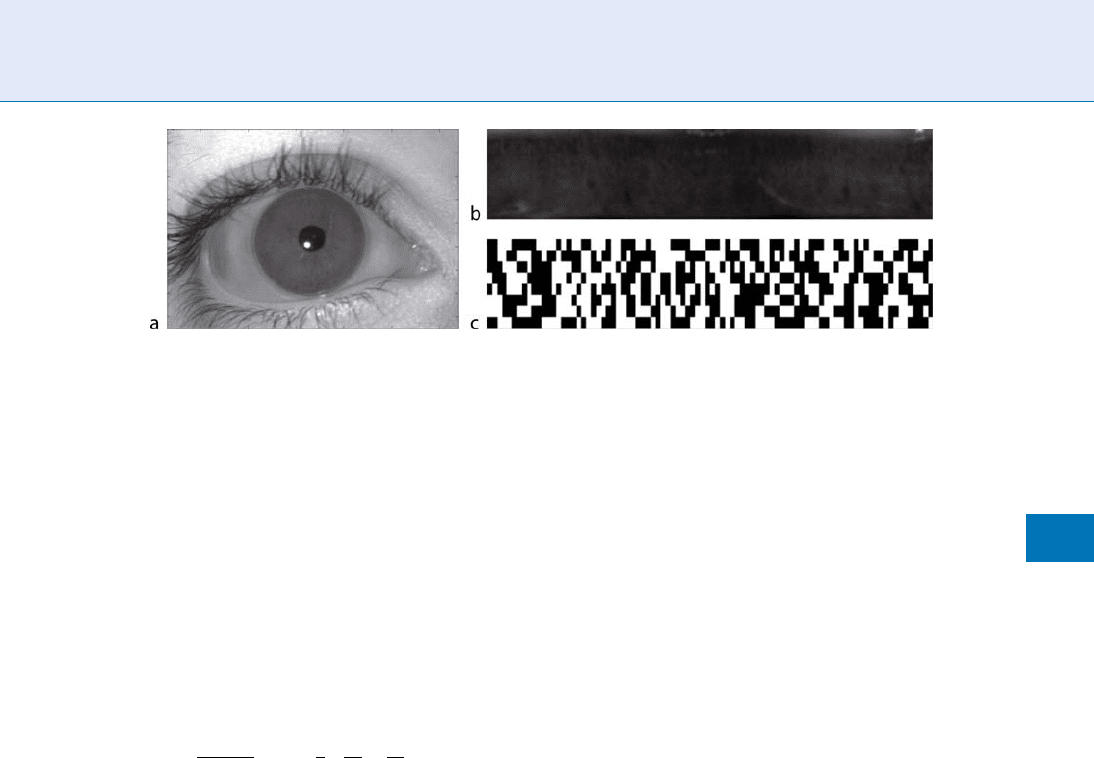Li S.Z., Jain A.K. (eds.) Encyclopedia of Biometrics
Подождите немного. Документ загружается.


Related Entries
▶ Biometric Data Interchange Format, Standardization
▶ Biometric Sensor and Device, Overview
▶ Biometric System Design
▶ Iris Acquisition Device
▶ Iris Encoding and Recognition
▶ Iris Image Quality
▶ Iris Recognition, Overview
▶ Iris Super-Resolution
References
1. Matey, J.R., Naroditsky, O., Hanna, K., Kolczynski, R., LoIacono,
D., Mangru, S., Tinker, M., Zappia, T., Zhao, W.Y.: Iris on the
Move™: acquisition of images for iris recognition in less con-
strained environments. Proc. IEEE 94(11), 1936–1947 (2006).
2. Mansfield, A., Kelly, G., Chandler, D., Kane, J.: ‘‘Biometric prod-
uct testing: final report’’ (CESG Contract X92A/4009309), Cen-
tre for Mathematics and Scientific Computing, UK National
Physical Laboratory (2001)
3. Daugman, J.: How iris recognition works. IEEE Trans. Circuits
Syst. Video Technol. 14(1), 21–30 (2004)
4. International Biometrics Group: Independent testing of iris rec-
ognition technology, Final report, May 2005, NBCHC030114/
0002. Study commissioned by the US Department of Homeland
Security
5. Bertillon, A.: La couleur de L’Iris. Annales de Demographie
Internationale 7 , 226–246 (1886)
6. Schwartzman, J. producer.: Never Say Never Again [motion
picture]. Warner Bros. (1983)
7. Daugman, J.: ‘‘Biometric personal identification system based on
iris analysis.’’ US Patent 5,291,560, 1 Mar 1994
8. Phillips, P.J., Scruggs, W.T., O’Toole, A.J., Flynn, P.J., Bowyer, K.W.,
Schott, C.L., Sharpe, M.: ‘‘FRVT 2006 and ICE 2006 large-
scale results.’’ NISTIR 7408, March 2007. See also http://iris.
nist.gov/
9. Daugman, J.: Probing the uniqueness and randomness of Iris-
Codes: results from 200 billion iris pair comparisons. Proc. IEEE
94(11), 1927–1935 (2006)
10. ISO/IEC: ‘‘Biometric data interchange formats – Part 6: Iris
image data’’ ISO/IEC JTC 1/SC 37 N 504 (2004)
11. Smith, W.J.: Modern Optical Engineering . McGraw-Hill, New
York (2000). ISBN 0-07-136360-2. http://en.wikipedia.org/wiki/
Depth_of_field
12. ACGIH: TLVs and BEIs (2006). ISBN 1-882417-62-3. www.
acgih.org
Iris Quality Metrics
▶ Iris Image Quality
Iris Reader
▶ Iris Acquisition Device
▶ Iris Device
Iris Recognition, Overview
YUNG-HUI LI
1
,MARIOS SAV VID ES
2
1
Language Technolog y Institute, Carnegie Mellon
University, Pittsbu rgh, PA, USA
2
Department of Electrical and Computer Engineering,
Carnegie Mellon University, Pittsburgh, PA, USA
Synonym
Iris Biometric
Definition
Iris recognition emerges as one of the most useful
modalities for biometrics recognition in last few dec-
ades. The goal of iris recognition is to recognize human
identity through the textural characteristics of one’s
iris muscular patterns. The procedures for iris recogni-
tion usually consist of four stages: image acquisition,
iris segmentation, feature extraction, and pattern
matching. The iris recognition has been acknowledged
as one of the most accurate biometric modalities
because of its high recognition rate. It has been applied
in the field of border control and national security.
More and more countries and private companies
have shown interests to use the technique of iris recog-
nition. Large scale application of iris recognition in
daily life is just a matter of time.
Introduction
The goal of biometric recognition is to recognize
human identity by comparing the features of their
physiological or behavioral characteristics. There are
dozens of such characteristics that can be found and
used for such purpose. Among them, fingerprint, face,
and voice are most famili ar to most people. However,
810
I
Iris Quality Metrics

the performance (in terms of the recognition rates) for
all the above modalities is not good enough for the
purpose of applications that require high level of
security.
Not very long ago, identity recognition based on
iris texture patterns is proposed as another modality
for biometric recognition [1–3]. Iris is the area that
appears as an annular shape between the pupil and the
sclera, as illustrated in Fig. 1. There are many advan-
tages of using iris as the modality of biometric recog-
nition. For example, iris pattern is developed and
becoming stable after the eighth month of gestation.
Besides, iris is well-protected by cornea, not easily
changed by external factors. Therefore, iris patterns
are very stable, relative to other modalities such as
face or voice, and very suitable to be used as a unique
feature for identity recognition. Another advan tage is
that randomness of the muscle of the iris region makes
possibility of sharing exactly the same iris pattern
among different persons very low, which provides
high discriminability for this feature.
A typical iris recognition system consists of the
following stages: iris image acquisition, iris segmen-
tation, feature extraction, and pattern matching, as
illustrated in Fig. 2. Image acquisition is of vital
importance in iris recognition performance because
the better the image quality, the more accurate result
the system can achieve. After iris image is acquired, the
next step is to locate the position of the iris and pupil.
Several techniques have been proposed and most of
them are based on image gradient and edge detection.
After iris has be en located, features of the iris textures
can be extracted. What feature to extract and how to
extract them is also important issue in iris recognition.
Good features give high inter-class variation and low
within-class variation, which is desired in common
biometric recognition system. Finally, one should be
able to compare features from different irises and ob-
tain a score of similarity which tells how similar these
two irises are (or a score of distance, which tells how
much different they are). Decision of classifying test
image as authentic or imposter is made by comparing
the similarity score with a given threshold.
Iris Image Acquisition
The area of iris is very small compared with the area of
the whole face. Therefore, it is not a trivial task to take
a clear iris image with high quality. On the other hand,
user-friendliness is also an important factor which
has to be considered in the process of iris image
acquisition. According to the user-friendliness and
the image quality, iris image acquisition device can be
categorized into three different groups. They are tradi-
tional iris acquisition device, middle distance iris ac-
quisition device, and long distance iris acquisition
device. Each of them is introduced in the following
paragraphs.
For traditional iris acquisition devices, in order to
take iris image s that contain enough useful detailed
Iris Recognition, Overview. Figure 2 Flow chart of a
typical iris recognition system.
Iris Recognition, Overview. Figure 1 Illustration of the
areas of pupil, iris and sclera.
Iris Recognition, Overview
I
811
I

information, people usually use cameras which
has specialized lens set up on a fixed stand. At the
same time, there is also a fixed stand for subjects to
lean their heads against. In this way, the system mini-
mized the possibilit y of subtle movement of subject’s
head during the iris image acquisition stage, and max-
imized the quality of the acquired iris image. Exemplar
images of traditional iris acquisition device are
shown in Fig. 3.
Traditional iris acquisition devices are good for
capturing high quality iris image, but extremely inflex-
ible and not user-friendly. It requires high level of user-
cooperation to successfully acquire iris image. Is it
possible to lower the level of required user-cooperation
and at the same time, maintain the high quality of the
eye image? Recently, progress of innovation in iris
acquisition device has made it possible to lessen the
requirement of user-cooperation while maintaining
high quality iris imag es. They can be categorized as
middle distance iris acquisition devices because they
can capture users’ iris images even when users stand at
a distance of 50–100 cm away from the camera. Users
are not required to put their heads against a rack.
Therefore, it is more user-friendly and convenient for
general public.
One of examples of middle distance iris acquisition
devices is the LG iCAM4000. The functional unit of LG
iCAM4000 is shown in Fig. 4, and an example picture
is shown when it is used to acquire a user’s iris image.
Long distance iris acquisition devices ar e able to
captureirisimagesevenwhenusersarestandingata
further distance, or even when they are moving. One
example of this kind of devices is the iris-on-the-move™
(IOM) manufactured by Sarnoff Corporation. The sys-
tem provides a portal which subjects are expected to
walk through. At the end of the walking aisle, four
high resolution infrared (IR) camera s are placed inside
a cabinet. During the time subjects are walking in the
portal, IR illuminators located at the wall of the portal
radiate IR light, at the same time, high resolution
cameras which tuned to sync with the illuminators
take continuous shots of the subjects. Then a face and
eye detector is applied on the image to find the loca-
tion of the eyes. The whole iris acquisition process is
fully automated and it only requires subjects to walk
through the portal, w ithout standing still or placing
Iris Recognition, Overview. Figure 3 (a) Example of traditional iris acquisition device (b) Example picture to illustrate
how to use it.
Iris Recognition, Overview. Figure 4 (a) LG iCAM4000 iris camera (b) Example picture to show how to use it.
812
I
Iris Recognition, Overview

their heads at a fixed position. In this way, the system
alleviates the inconvenience of the tr aditional iris
acquisition devices while being able to maintain a
reasonable quality of the eye pictures.
Figure 5 shows pictures of IOM system.
It is very intuitive that the system which requires
least user cooperation (more user-friendly) has the
highest probability of getting eye images of lowest
quality. For example, the IOM system is very user-
friendly. It does not require users to stand still at a
particular point to get their iris images. However, the
eye image s taken from IOM are very easy to be blurred
or out of focus. This is because the images may be
taken when the subjects are walking in a region which
is outside of the depth of the field of the cameras.
Recently, a new camera system design has been
proposed to address this issue. Dowski and Johnson
proposed a low cost imaging system which combines
the nonrotationally symmetric aspheric optical ele-
ments and digital signal processing in a fundamen-
tal manner to vastly extend the depth of field of
the imaging systems [4]. It is called ‘‘Wavefront Cod-
ing’’ imaging system. The block diagram of the Wave-
front Coding system is shown in Fig. 6. The optical
section is modified by adding a generalized aspheric
Wavefront Coding optical element near the aperture
stop. This will make the images formed on CCD to
have a specially well-defined blur that is insensitive to
misfocus. Digital image processing technique is ap-
plied to the blurred image to reproduce the sharp
and clear image. Optical systems aided with Wavefront
Coding are able to reproduce a clear and focused image
even when the subject is standing at the out of focus
zone. For more details, please refer to [4].
Iris Segmentation
No matter which kind of iris acquisition device is
used, the eye image taken usually looks like the one
in Fig. 1. Therefore, it is necessary to locate the iris
region in this imag e and focus our future process
Iris Recognition, Overview. Figure 5 (a) IOM system. Camera cabinet is on the left; the portal is on the right, behind the
subject. (b) Example picture of subject walking through the portal.
Iris Recognition, Overview. Figure 6 Block diagram of Wavefront Coding imaging system.
Iris Recognition, Overview
I
813
I

(feature extraction and pattern matching) on this re-
gion alone. The process of locating iris region is called
iris segmentation.
As stated above, iris region is of annular shape.
Therefore, it is intuitive to segment iris with two
circles: one circle indicates the boundary between
iris and pupil, and the other indicates the boundary
between iris and sclera. The texture in the region
between these two circles is exactly what we need for
further process.
There exist different algorithms which ser ve the
same goal of iris segmentation. One of the most popu-
lar algorithms is proposed by Wildes [5]. There are two
steps in this algorithm. The first step is to apply a
gradient-based edge detector on the whole eye image
to generate an edge-map. The edge-map tells us the
position where strong edges exist (strong differences in
pixel values). Intuitively, those positions are possible
candidates of the iris boundaries since the two bound-
aries of iris, both inner and outer, are the positions
where high pixel contrast takes place. The second step
is to find the exact two boundaries from this edge-
map. The method Wildes used is a voting scheme.
Every circle on a 2D plane can be described by three
parameters, coordinate in x and y axis, and the radius r.
Therefore, one can construct a three-dimensional
(3D) space, where each dimension represents one
parameter. Every positive pixel on the edge-map can
vote to the point ( x, y, r) in the 3D parameter space as
long as this positive pixel is on the perimeter of the
circle which is parameterized as ( x, y, r). Since different
circles can pass through the same point, it is possible
for 1 pixel on the edge-ma p to vote to multiple points
in 3D parameter space. At last, the point which has the
highest accumulated votes represents the most likely
circle in the original eye image. An example of iris
segmentation is shown in Fig. 7a.
Daugman proposed another segmentation scheme
[6, 7] which is different from what Wildes proposed.
He suggested computing the argument which maxi-
mizes the result of an integrodifferential operator on
the original image. It is described in the following
equation:
max
ðr;x
0
;y
0
Þ
G
s
@
@r
þ
r;x
0
;y
0
Iðx; yÞ
2pr
ds
: ð1Þ
The triple (r, x
0,
y
0
) which satisfied Eq. 1 is the best
candidate parameter for a circle in the original image.
By applying Eq. 1 twice, we will be able to locate the
boundaries for both iris and pupil. To locate the eyelid
boundary, one only need s to change the form of inte-
grodifferential operator in Eq. 1 from circular to
Iris Recognition, Overview. Figure 7 (a) A raw eye image with iris boundaries identified as red circles (b) segmented iris
image after masking out unuseful region (c) illustration of the meaning of parameter R and y (d) unwrapped iris image in
polar coordinate.
814
I
Iris Recognition, Overview

arcuate, with spline parameters, because the shape of
eyelid is most likely to be arcuate.
After observing large number of iris images, one
sooner or later discovers that in fact, the boundaries
of iris and pupil are not exactly circular. They appear as
circular images of low resolution. However, for images
of higher resolution, it is easy to see that using a circular
boundary to describe them is not very accurate.
Therefore, Daugman, in his later work [8], pro-
posed a new segmentation method. He proposed to
use a more flexible model to represent both bound-
aries. This method is called ‘‘active contour,’’ or
‘‘snakes.’’ By using snakes, the boundary of the pupil
and iris is not bounded to circular. They can be of any
shape. Therefore, the discovered boundaries can fit to
the real data more closely, and bring performance
enhancement in the pattern matching stage. The points
of snakes are initialized at the points from sampling N
regularly spaced angular samples of radial gradient
edge data. We have to first estimate the Fourier series
expansion of those samples of radial gradient edge
data, as described in the following equation:
C
k
¼
X
N1
y¼0
r
y
e
2piky=N
; ð2Þ
where {r
y
} is the radial gradient edge data, y =0N–1.
We compute C
k
from k =0tok = M1. Then we
compute an approximation of the iris boundary {R
y
}
for y =0(N–1), as described below:
R
y
¼
1
N
X
M1
y¼0
C
k
e
2piky=N
: ð3Þ
The number of M controls the smoothness of the
curve. The larger the M, the more flexible the curve is;
and the smaller the M, the less flexible the curve. By
choosing M carefully one can make the discovered
boundaries fit the data more closely and not being
affected by the noises (eyelid or eyelashes).
Most of the time, after iris localization, we would
like to do an image coordinate transformation on the
iris image. The goal of coordinate transformation is to
transform the annular-shaped iris region into rectan-
gular shape, by mapping pixel values from Cartesian
coordinate to polar coordinate. The process is illu-
strated in Fig. 7.InFig. 7b, the region which is unim-
portant for iris recognition is masked out, leaving
only iris texture visible. This iris image is displayed in
Cartesian coordinate. If we pick the center of the pupil
as the origin, and the horizontal line as x-axis, every
point on iris region can be indexed by another coordi-
nate, which is polar coordinate. Polar coordinate is
parameterized with two parameters: R and y, and
the computation of R and y is illus trated in Fig. 7c.If
we take out every pixel in iris region in Fig. 7c and
replot them according to the coordinate ( R, y), we will
get Fig. 7d, which is the iris texture map in polar
coordinate.
There are two advantages of coordinate transfor-
mation. First, the size of the pupil area is not always the
same. It contracts when the ambient lighting is strong
and dilates when the ambient lighting is weak. There-
fore, if we would like to take the iris image in Cartesian
coordinate to perform pattern matching, one problem
is the nonlinear deforma tion of the pattern, which
require much more complex technique to solve. In-
stead, if we perform coordinate transformation for
every iris texture, no matter how much pupil contracts
or dilates, the resulting iris texture map in polar coor-
dinate w ill remain the same. This saves us a lot of
trouble during the later matching stage.
The second problem is, when we take pictures of
eyes, if we are not using traditional iris acquisition
device, it is highly possible that the position of our
camera has relative rotational shift to the subject’s
head. It is very likely to happen because users can freely
move their head in any direction, as long as the eye
images can be captured. If there is indeed relative rota-
tional shift between cameras and the eyes, this is going
to cause another trouble during later matching stage.
This is because matching two patterns with potential
rotational shift is a difficult problem in pattern recog-
nition field. Instead, if the iris image is unwrapped
to polar coordinate before featu re extraction and
matching stage, rotational shift in Cartesian coordi-
nate becomes translational shift in horizontal direc-
tion (y axis). Therefore, all we need to do is simply
shift the pattern horizontally in different step sizes
and perform matching again to get correct matching
result.
Feature Extraction
After iris region has been identified and cropped out,
the next step is to perform feature extraction on the
iris texture. The goal of feature extraction is to extract
the discriminative charac teristic of the iris texture and
store it in a more compact way so that it is more
effective to perform pattern matching in a later stage.
Iris Recognition, Overview
I
815
I

Most of the time, in the field of image processing
and pattern recognition, the feature extraction is ac-
complished by applying filters on the input images.
In literature, the filters which have been used exten-
sively in iris recognition, are Gabor filters, proposed
by J. Daugman [2, 6, 9, 10, 7]. Gabor filters can be seen
as complex sinusoids modulated by Gaussian envelope.
They can be expressed as the following equation:
Cðx; yÞ¼A e
1
2
x
2
s
2
x
þ
y
2
s
2
y
joðcos yÞxjoðsin yÞy
hi
; ð4Þ
where, by convention, the standard deviations of the
envelope are inversely propor tional to frequency o:
s
x
¼ k
x
2p
o
s
y
¼ k
y
2p
o
:
ð5Þ
We can generate multiple Gabor filt ers of different
sizes, orientation, or frequency by substituting differ-
ent parameters in Eq. 4. Gabor filters of different
orientation and frequency can capture different texture
details in iris texture. An example of Gabor filter as w ell
as Gaussian derivative filter are shown in Fig. 8.
We get a two-dimensional (2D) complex-valued
plane after applying each Gabor filter on iris texture.
Daugman proposed a
▶ phase-quadrant quantization
scheme to further quantize the 2D complex-valued
plane. Because amplitude information depends on ex-
traneous factors such as imaging contrast, illumina-
tion, and camera gain, it is not very discriminating. On
the contrary, phase information on a complex-valued
filter response plane has been shown to have much
more discriminative information in biometric recog-
nition [7, 11]. Therefore, performing phase quantiza-
tion would discard useless information and at the same
time, make feature representation more compact and
easy to handle.
The phase-quadrant quantization scheme amounts
to a patch-wise phase quantization of the iris pattern, by
identifying in which quadrant of the complex plane each
resultant phasor lies. For every location on the complex
plane, the sign of real and imaginary part jointly defines
in which quadrant the phasor lies. Two bitcodes are used
to encode the four possible quadrants. The phase-quad-
rant quantization scheme is illustrated in Fig. 9.
The phase-quadrant demodulation process is re-
peated across all the plane of the response of the filters,
with many different wavelet sizes, frequencies, and
orientations to extract totally 2048 bits. Figure 10
shows the raw eye image, unwrapped iris texture in
polar coordinate, and the iris code after feature
extraction.
Besides Gabor filters, there are also other ty pe of 2D
filters that can be used in iris feature extraction. Zhu
Iris Recognition, Overview. Figure 8 Examples of two filters which can be used for iris feature extraction. (a) Directional
Gaussian derivative filter, in 2D view (b) Directional Gaussian derivative filter, in 3D view (c) Gabor filter, in 2D view
(d) Gabor filter, in 3D view.
Iris Recognition, Overview. Figure 9 Illustration of
Daugman’s phase-quadrant demodulation scheme.
According to the quadrant each complex number falls in,
the angle of the phasor is quantized to one of the four
quadrants, setting two bits of phase information. This
process is repeated across all the iris with many wavelet
sizes, frequencies, and orientations.
816
I
Iris Recognition, Overview

et al. proposed to use 2D wavelet transform to perform
feature extr action [12]. By applying 2D wavelet trans-
form on an iris texture map, one can get a set of sub-
images of different resolution levels. They proposed to
use the mean and variance (or standard deviation) of
each wavelet sub-images to be the features.
Ma et al. proposed to use circular symmetric filters
to perform iris feature extraction [13, 14]. The kernels
of circular symmetric filters can be defined as follows:
Gðx; y; f Þ¼
1
2pd
x
d
y
exp
1
2
x
2
d
2
x
þ
y
2
d
2
y
!"#
Mðx; y; f Þ
Mðx; y; f Þ¼cos 2pf
ffiffiffiffiffiffiffiffiffiffiffiffiffiffiffi
x
2
þ y
2
p
hi
; ð6Þ
where f is the frequency of the modulating sinusoidal
function, d
x
and d
y
are the space constants of the
Gaussian envelope along the x and y axis, respectively.
The difference between circular symmetric filters and
Gabor filters is that Gabor filter of a fixed parameter
focus only on information obtained from a specific
orientation; w hile circular sy mmetric filters extract
information from all orientation. Circular symmetric
filters can also put more emphasis on a par ticular
orientation, by changing the parameter d
x
and d
y
.
After iris texture has been convolved with circular
symmetric filters, they proposed to extract the mean
and the average absolute deviation of the magnitude of
local patches (of size 8 8) of the convolved image as
feature vectors. Finally, Fisher line ar Discriminant
analysis was applied to reduce the dimensionality of
the feature vectors.
One last thing to note is that, very often, iris texture
is occluded by other objects, for example, eye lashes,
eye lids, or specular reflection from eye glasses, it is not
that every point on the iris texture map is useful for
pattern matching. Therefore, it is necessary to compute
an iris mask, which is exactly the same size as iris
texture, to indicate which part of the map is really
iris texture, and which part is not. This mask will be
used in the stage of pattern matching, as described in
the next section.
Pattern Matching
After iris code and its mask have been computed, the
next step is to match two irises to see if they are coming
from the same class. Obviously, to complete the task,
the only thing one has to do is to count how many bits
of these two irises share the same value. One thing to
note is that when we compare the differences of each
bit, we must not count the bit which belongs to the
region that is not iris texture. Therefore, we have to
mask out non-iris region before we compute the
matching score.
Another thing to note is that since we already
quantize the feature of iris texture into binary values,
there are only two possible values for each location on
iris map (1 or 0). There exists one operation which can
be executed extremely fast to compare if 2 bits share
the same value, which is the exclusive-or operation
(XOR). XOR returns zeros if both bits are the same
(both of them are zeros or ones), ones if they are
different (one of them is 0 and the other is 1). There-
fore, by performing bit-wise XOR operation, one can
compute the distance score for two irises in extremely
high efficiency.
To summarize, suppose we want to compare the
distance be tween iris A and B, whose two phase code
bit vectors are denoted {code_A, code_B} and whose
Iris Recognition, Overview. Figure 10 (a) Eye image with segmentation in Cartesian coordinate (b)
unwrapped iris image in polar coordinate (c) iris code computed by applying Gabor filters on (b) then perform
bit-wise quantization.
Iris Recognition, Overview
I
817
I

mask bit vectors are denoted {mask_A, mask_B}, it can
be computed simply by following equation:
HD ¼
ðcode A code BÞ\mask A \ mask B
kk
mask
A \ mask B
kk
;
ð7Þ
where
N
denotes bit-wise_ XOR operation, \ denotes
bit-wise AND operation, and
kk
denotes the norms of
the resultant bit.
The computed score is a metric of ‘‘distance,’’
indicating how different these two irises are. It is
called ‘‘Hamming Distance’’ (HD). As one can see
from Eq. 7, Hamming Distance is normalized by the
norm of the effective region. Therefore, it will always
have values between 0 and 1, where 0 indicates if iris
A and B are exactly the same and 1 indicates if they are
completely opposite.
Ideally, if two irises are from the same class, the
Hamming Distance between them should be close to 0.
On the other hand, if two irises are from different
classes, due to the property of statistical independence,
the probability for each bit of one iris to match the
same bit of another iris should be 50%. Therefore, the
expected Hamming Distance for two irises which come
from different classes should be 0.5. In practice, the
values of Hamming Distance will not be exactly 0 or
0.5. The distribution of the value of Hamming Dis-
tance for authentic comparison will be a Gaussian
distribution, centered at 0, and the distribution of the
value of Hamming Distance for imposte r comparison
will be another Gaussian distribution, centered at 0.5.
If the qualit y of the input iris image is high enough, in
most cases, these two Gaussians would not intersect
with each other, or they only intersect with each other
in tiny portion. Therefore, a proper threshold can be
chosen to minimize both the
▶ False Positive Rate and
▶ False Negative Rate.
Summary
Iris recognition is an emerging field for biometric
recognition. Substantial research effor ts have been
involved in this field to push the performance of iris
recognition to the limit. Literature has shown that it is
one of the biometric modality that has high perfor-
mance, high universality, high distinctiveness, high
permanence, and low chances of circumvention [15].
As the technological innovation of iris acquisition
keeps advancing, it is becoming more user-friendly
and more popular. As the computational power of
hardware grows exponentially and the size of chip
keeps decreasing, iris segmentation, feature extraction,
and matching can all be executed faster in much smal-
ler devices. In the near future, it is very promising that
iris recognition system will be widely accepted, not
only in the application at national security level, but
also in private companies, public services, and private
residency.
Related Entries
▶ Biometrics Overview
▶ Biometric System Design
▶ Iris Acquisition Device
▶ Iris Encoding and Recognition
References
1. Flom, et al.: Iris recognition system. US Patent 4641349, 3
Feb 1987
2. Daugman, J.: Biometric personal identification system based on
iris analysis. US Patent 5291560, 1 Mar 1994
3. Wildes, et al.: Automated non-invasive iris recognition system
and method. US Patent 5572596, 5 Nov 1996
4. Dowski, E.R. Jr., Johnson, G.E.: Wavefront coding: a modern
method of achieving high-performance and/or low-cost imaging
systems. Proc. SPIE 3779, 137 (1999), DOI:10.1117/12.368203
5. Wildes, R.: Iris recognition: An emerging biometric technology.
Proc. IEEE 85, 1348–1363 (1997)
6. Daugman, J.: High confidence visual recognition of persons by a
test of statistical independence. IEEE Trans. Pattern Anal. Mach.
Intell. 15(11), 1148–1161 (1993)
7. Daugman, J.: How iris recognition works. IEEE Trans. Circ. Syst.
video Technol. 14(1), 21–30 (2004)
8. Daugman, J.: New methods in iris recognition. IEEE Trans. Syst.
Man Cybern. Part B, 37(5), 1167–1175 (2007)
9. Daugman, J.: Statistical richness of visual phase information:
Update on recognizing persons by iris patterns. Int. J. Comput.
Vis. 45(1), 25–38 (2001)
10. Daugman, J.: The importance of being random: Statistical prin-
ciples of iris recognition. Pattern Recognit. 36(2), 279–291
(2003)
11. Savvides, M., Kumar, B.V.K.V., Khosla, P.K.: Eigenphases vs
eigenfaces. In: Proceedings of the 17th International Conference
on Pattern Recognition 2004 (ICPR 2004), vol. 3, pp. 810–813
vol. 3, 23–26 (Aug 2004)
12. Zhu, Y., Tan, T., Whang, Y.: Biometric personal identification
based on iris patterns. In: Proceedings of International Confer-
ence on Pattern Recognition, pp. 2801–2804. Barcelona, Spain
(2000)
818
I
Iris Recognition, Overview

13. Ma, L., Tan, T., Wang, Y., Zhang, D.: Personal identification
based on iris texture analysis. IEEE Trans. Pattern Anal. Mach.
Intell. 25(12), 1519–1533 (2003)
14. Ma, L., Wang, Y., Tan, T.: Iris recognition using circular sym-
metric filters. In: Proceedings of International Conference on
Pattern Recognition, pp. 414–417 (2002)
15. Jain, A.K., Ross, A., Prabhakar, S.: An introduction to biometric
recognition. IEEE Trans. Circ. Syst. Video Technol. 14(1), 4–20
(2004)
Iris Recognition Algorithms
An iris recognition algorithm is a method of matching
an iris image to a collection of iris images that exist in a
database. There are many iris recognition algorithms
that employ different mathematical ways to perform
recognition. Breakthrough work by John Daugman
led to the most popular algorithm based on Gabor
wavelets.
▶ Iris Acquisition Device
Iris Recognition at Airports and
Border-Crossings
JOHN DAUGMAN
Computer Laborato ry University of Cambridge,
Cambridge, UK
Synonyms
CANPASS; CLEAR; Iris recognition immigration sys-
tem (IRIS); NEXUS; Privium; RAIC
Definition
As case illustrations of generic biometric applications,
there are at least five different modes in which auto-
mated personal identification by iris recognition is
used at airports: (1) international arriving passengers
can clear Immigration control at iris-automated gates
without passport or other identity assertion if they
have been enrolled in a preapproved iris database;
(2) departing passengers can receive expedited security
screening and check-in as low-risk travelers if enrolled
in an iris database following background checks;
(3) airline crew members use iris recognition for con-
trolled access to the secure air-side; (4) airport employ-
ees gain access to restricted areas within airports such
as maintenance facilities, baggage handling, and the
tarmac; and (5) arriving passengers may be screened
against a watch-list database recording the irises of
persons deemed dangerous, or of expellees excluded
from entering a country. All such existing programs
use the Daug man algorithms for iris encoding and
recognition because of the need to process iris images
fully at the speed of the vid eo frame rate (30frames/s)
and to search databases at speeds of about a million
IrisCodes per second, and the need for robustness
against making False Matches in large databas e
searches despite so many opportunities. However,
the threat models posed for the different applications
are distinctive, depending on whether an attacker’s
goal is a False non-Match (a concealment attack, e.g.,
in a watch-list application) or a False Match (an
impersonation attack, e.g., to be taken for a registered
traveler in an expedited Immigration control or
trusted-traveler deployment). Likewise, the business
models vary for these different uses, depending
on whether the traveler pays for the convenience of
expedited processing, or an airport owner pays for
the facility’s enhanced security and productivity, or a
government funds such a technology deployment both
to improve process efficiency and to achieve national
security goals.
Introduction
Most deployments of biometric systems have as their
main purpose either enhancing the security and reliabil-
ity, or enhancing the convenience and efficiency, of an
identification process. In some applications either secu-
rity or efficiency dominates the requirement, while the
other is less important. For example, in identifying
theme park visitors biometrically in lieu of ticketing,
efficiency is much more important than security; where-
as for biometric applications within prisons or detention
centers, just the opposite is the case. In airports, how-
ever, both of these objectives are paramount, and neither
can be compromised. Excelling simultaneously at both
Iris Recognition at Airports and Border-Crossings
I
819
I
